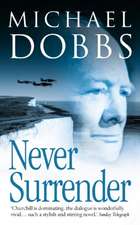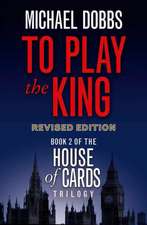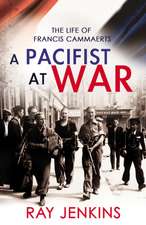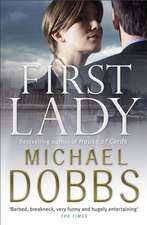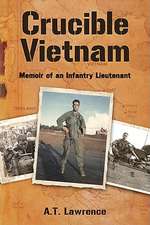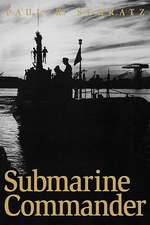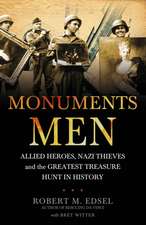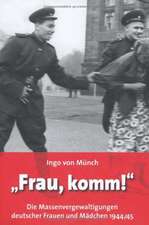One Minute to Midnight: Kennedy, Khrushchev, and Castro on the Brink of Nuclear War
Autor Michael Dobbsen Limba Engleză Paperback – 31 mai 2009
Vezi toate premiile Carte premiată
L.A. Times Book Prize (2008)
Here, for the first time, are gripping accounts of Khrushchev's plan to destroy the U.S. naval base at Guantánamo; the handling of Soviet nuclear warheads on Cuba; and the extraordinary story of a U-2 spy plane that got lost over Russia at the peak of the crisis.
Written like a thriller, One Minute to Midnight is an exhaustively researched account of what Arthur Schlesinger, Jr. called “the most dangerous moment in human history,” and the definitive book on the Cuban missile crisis.
Preț: 110.34 lei
Nou
Puncte Express: 166
Preț estimativ în valută:
21.12€ • 21.81$ • 17.57£
21.12€ • 21.81$ • 17.57£
Carte indisponibilă temporar
Doresc să fiu notificat când acest titlu va fi disponibil:
Se trimite...
Preluare comenzi: 021 569.72.76
Specificații
ISBN-13: 9781400078912
ISBN-10: 1400078911
Pagini: 426
Ilustrații: 24 PP. B&W/7 MAPS
Dimensiuni: 137 x 199 x 24 mm
Greutate: 0.45 kg
Editura: Vintage Books USA
ISBN-10: 1400078911
Pagini: 426
Ilustrații: 24 PP. B&W/7 MAPS
Dimensiuni: 137 x 199 x 24 mm
Greutate: 0.45 kg
Editura: Vintage Books USA
Notă biografică
Michael Dobbs was born in Belfast, Ireland, and educated at the University of York, with fellowships at Princeton and Harvard. He is a reporter for The Washington Post, where he spent much of his career as a foreign correspondent covering the collapse of communism. His Down with Big Brother: The Fall of the Soviet Empire was a runner-up for the 1997 PEN award for nonfiction. He lives in Bethesda, Maryland.
Extras
Americans
Tuesday, October 16, 1962, 11:50 a.m.
The Central Intelligence Agency’s chief photo interpreter hovered over the president’s shoulder. Arthur Lundahl held a pointer in his hand, ready to reveal a secret that would bring the world to the edge of nuclear war.
The secret was buried in three black-and-white photographs pasted to briefing boards hidden in a large black case. The photographs had been shot from directly overhead, evidently from a considerable distance, with the aid of a very powerful zoom lens. On superficial inspection, the grainy images of fields, forests, and winding country roads seemed innocuous, almost bucolic. One of the fields contained tubelike objects, others oval-shaped white dots neatly lined up next to one another. John F. Kennedy would later remark that the site could be mistaken for “a football field.” After examining the photographs earlier that morning, his brother Bobby had been unable to make out anything more than “the clearing of a field for a farm or the basement of a house.”
To help the president understand the significance of the photos, Lundahl had labeled them with arrows pointing to the dots and blotches, along with captions reading “ERECTOR LAUNCHER EQUIPMENT,” “MISSILE TRAILERS,” and “TENT AREAS.” He was about to display the briefing boards when there was a commotion outside the door. A four-year-old girl burst into one of the most heavily guarded rooms in the White House.
The heads of the fourteen most powerful men in the United States swiveled to the doorway as Caroline Kennedy ran toward her father, babbling excitedly: “Daddy, daddy, they won’t let my friend in.”
The somber-looking men in dark suits were used to such intrusions. Their frowns dissolved into smiles as the president got up from his leather-upholstered seat and led his daughter back toward the door of the Cabinet Room.
“Caroline, have you been eating candy?”
No reply. The president smiled.
“Answer me. Yes, no, or maybe.”
Father and daughter disappeared for a few seconds, his arm draped around her shoulders. When Kennedy returned, his expression had again become grave. He took his place at the center of the long table beneath the presidential seal, his back to the Rose Garden. He was flanked on either side by his secretary of state and secretary of defense. Facing him across the table were his brother, his vice president, and his national security adviser. Behind them stood a small bronze bust of Abraham Lincoln, flanked by some model sailing ships. Above the fireplace to the right was the celebrated Gilbert Stuart portrait of a powdered and bewigged George Washington.
The thirty-fifth president of the United States called the meeting to order.
Kennedy seemed preternaturally calm to the other men in the room as he listened to the evidence of Kremlin duplicity. In secrecy, while insisting they would never contemplate such a thing, the Soviet leaders had installed surface-to-surface nuclear missiles on Cuba, less than a hundred miles from American shores. According to the CIA, the missiles had a range of 1,174 miles and were capable of hitting much of the eastern seaboard. Once armed and ready to fire, they could explode over Washington in thirteen minutes, turning the capital into a scorched wasteland.
Lundahl took the briefing boards out of his bag and laid them on the table. He used his pointer to direct the president’s attention to a canvas-covered missile trailer next to a launcher erector. Seven more missile trailers were parked in a nearby field.
“How do you know this is a medium-range ballistic missile?” asked the president. His voice was clipped and tense, betraying a boiling anger beneath the calm.
“The length, sir.”
“The what? The length?”
“The length of it, yes.”
CIA experts had spent the last thirty-six hours poring over thousands of reconnaissance photographs of the hills and valleys of western Cuba. They had discovered telltale cables connecting one of the tubelike objects to the nearby oval-shaped splotch, and had used a revolutionary new computer device that filled up half a room—the Mann Model 621 comparator—to measure its length. The tubes turned out to be sixty-seven feet long. Missiles of identical length had been photographed at military parades in Red Square in Moscow.
The president asked the obvious question: when would the missiles be ready to fire?
The experts were unsure. That would depend on how soon the missiles could be mated with their nuclear warheads. Once mated, they could be fired in a couple of hours. So far, there was no evidence to suggest that the Soviets had moved the warheads to the missile sites. If the warheads were present, one would expect to see some kind of secure storage facility at the missile sites, but nothing was visible.
“There is some reason to believe the warheads aren’t present and hence they are not ready to fire,” said Defense Secretary Robert S. McNamara. The computerlike brain of the former head of the Ford Motor Company clicked away furiously, calculating the chances of a surprise attack. He believed the president still had some time.
The chairman of the Joint Chiefs of Staff disagreed. General Maxwell Taylor had parachuted into Normandy during World War II, and had commanded Allied forces in Berlin and Korea. It fell to him to point out the risks of delay. The Soviets could be in a position to fire their missiles “very quickly.” Most of the infrastructure was already in place. “It’s not a question of waiting for extensive concrete pads and that sort of thing.”
The president’s advisers were already dividing into doves and hawks.
Kennedy had received an initial intelligence briefing earlier that morning. His national security adviser, McGeorge Bundy, had knocked on the door of his bedroom, on the second floor of the White House, shortly after 8:00 a.m. The president was propped up in bed, in pajamas and dressing gown, reading the morning newspapers. As often happened, he was annoyed by a page-one headline in The New York Times. On this particular morning, his exasperation was directed at his predecessor, Dwight D. Eisenhower, who had broken the unwritten convention of former presidents refraining from publicly criticizing the current occupant of the Oval Office.
EISENHOWER CALLS PRESIDENT WEAK ON FOREIGN POLICY
—
Denounces “Dreary Record,” Challenging Statements by Kennedy on Achievements
—
HE SEES SETBACK TO U.S.
As Bundy described the latest U-2 mission over Cuba, Kennedy’s irritation with Ike was replaced by a burning anger toward his Cold War nemesis. Over the past two years, he and Nikita Khrushchev had been engaged in a very public game of nuclear oneupmanship. But Kennedy thought he had an understanding with the mercurial Soviet premier. Khrushchev had sent word through intermediaries that he would do nothing to embarrass the U.S. president politically before the midterm congressional elections, which were exactly three weeks away.
News that the Soviets were constructing missile bases on Cuba could hardly have come at a worse time. During the 1960 presidential election, Kennedy had used Cuba as a stick to beat the Republicans, accusing the Eisenhower government of doing nothing to prevent Fidel Castro from transforming the island into “a hostile and militant Communist satellite.” Now that the Democrats were in power, the political roles were reversed. Republican politicians were seizing on reports of a Soviet military buildup on Cuba to denounce Kennedy for weakness and fecklessness. Just two days earlier, Kennedy had sent Bundy out on nationwide television to knock down a claim by the Republican senator from New York, Kenneth B. Keating, that the Soviets would soon be able “to hurl rockets into the American heartland” from their Caribbean outpost.
Kennedy’s immediate reaction on learning from Bundy that Khrushchev had double-crossed him was to sputter, “He can’t do this to me.” An hour later, he walked into the office of his appointments secretary, Kenny O’Donnell, and announced glumly, “Ken Keating will probably be the next president of the United States.”
Determined to keep the information secret as long as possible, Kennedy decided to stick to his regular schedule, acting as if nothing was amiss. He showed off Caroline’s pony Macaroni to the family of a returning astronaut, chatted amiably for half an hour with a Democratic congressman, and presided over a conference on mental retardation. It was not until nearly noon that he managed to break away from his ceremonial duties and meet with his top foreign policy advisers.
Kennedy conceded that he was mystified by Khrushchev. Alternately ingratiating and boorish, friendly and intimidating, the metalworker turned superpower leader was unlike any other politician he had ever encountered. Their single summit meeting—in Vienna, in June 1961—had been a brutal experience for Kennedy. Khrushchev had treated him like a little boy, lecturing him on American misdeeds, threatening to take over West Berlin, and boasting about the inevitable triumph of communism. Most shocking of all, Khrushchev did not seem to share his alarm about the risks of nuclear war, and how it could be triggered by miscalculations on either side. He spoke about nuclear weapons in a casual, offhand kind of way, as simply one more element in the superpower competition. If the United States wants war, he blustered, “let it begin now.”
“Roughest thing in my life,” Kennedy had told James Reston of The New York Times, after it was all over. “He just beat the hell out of me.” Vice President Lyndon B. Johnson was contemptuous of his boss’s performance. “Khrushchev scared the poor little fellow dead,” he told his cronies. British prime minister Harold Macmillan, who met with Kennedy shortly after he left Vienna, was only slightly more sympathetic. He thought that the president had been “completely overwhelmed by the ruthlessness and barbarity of the Russian Chairman.” For the first time in his life Kennedy had met a man “who was impervious to his charm,” Macmillan noted later. “It reminded me in a way of Lord Halifax or Neville Chamberlain trying to hold a conversation with Herr Hitler.”
Part of the problem lay in Kennedy’s own miscalculations as president. The biggest mistake of all was the Bay of Pigs. In April 1961, four months after taking office, he had authorized an invasion of Cuba by fifteen hundred CIA-trained Cuban exiles. But the operation was disastrously planned and executed. Castro mounted a vigorous counterattack, trapping the exiles in an isolated beachhead. Anxious to conceal official American involvement as much as possible, Kennedy refused to order U.S. ships and planes stationed just offshore to come to the rescue of the outnumbered invaders, most of whom ended up in Castro’s jails. As Kennedy later confessed to Reston, his superpower rival had no doubt concluded that “I’m inexperienced. Probably thinks I’m stupid. Maybe most important, he thinks that I had no guts.” The perception of an inexperienced leader with no guts was one that he had been struggling to reverse ever since.
The news from Cuba reinforced Kennedy’s impression of Khrushchev as a “fucking liar.” He complained to his brother that the Soviet leader had behaved like “an immoral gangster . . . not as a statesman, not as a person with a sense of responsibility.”
The question was how to respond. They would definitely step up U-2 reconnaissance of the island. Military options ranged from an air strike targeted on the missile sites alone to an all-out invasion. General Taylor warned that it would probably be impossible to destroy all the missiles in a single strike. “It’ll never be a hundred per cent, Mr. President.” Any military action was likely to escalate quickly to an invasion. The invasion plan called for as many as a hundred and fifty thousand men to land in Cuba a week after the initial air strikes. In the meantime, the Soviets might be able to launch one or two nuclear missiles against the United States.
“We’re certainly going to do [option] number one,” Kennedy told his aides grimly, referring to the air strike. “We’re going to take out those missiles.”
Tuesday, October 16, 2:30 p.m.
Robert Kennedy still had an angry glint in his eye later that afternoon when he met the men in charge of America’s secret war against Fidel Castro in his cavernous Justice Department office. He was determined to make clear the president’s “dissatisfaction” with Operation Mongoose, which had been under way for a year, achieving virtually nothing. Countless acts of sabotage had been planned, but none had been carried out successfully. Fidel and his bearded revolutionaries were still in power, inflicting daily humiliations on the United States.
Officials from the CIA, the Pentagon, and the State Department were arrayed in a semicircle in front of the attorney general. A fresh assortment of his children’s watercolors decorated the walls, along with standard-issue government art. One of the documents on the untidy, paper-littered desk was a two-page memorandum captioned “secret mongoose” with the latest ideas for fomenting an insurrection inside Cuba. It had been put together by the CIA in response to prodding from the Kennedy brothers to be much more “aggressive.” RFK nodded approvingly as he glanced through the list:
• Demolition of a railroad bridge in Pinar del Río province;
• Grenade attack on the Chinese Communist embassy in Havana;
• Mine the approaches to major Cuban harbors;
• Set an oil tanker afire outside Havana or Matanzas;
• Incendiary attacks against oil refineries in Havana and Santiago.
The attorney general title masked Bobby’s true role in government, which was closer to that of deputy president. His extracurricular responsibilities included heading a secret committee known as the Special Group (Augmented), whose goal was to “get rid of” Castro and “liberate” Cuba from Communist domination. The addition of the president’s brother to the group—signified by the cryptic word “Augmented”—was a way of emphasizing its importance to the rest of the bureaucracy. Soon after taking personal control of Operation Mongoose in November 1961, Bobby had decreed that “the Cuban problem carries top priority in the U.S. government. No time, money, effort, or manpower is to be spared.” By coincidence, he had arranged a long-scheduled review of covert action plans against Cuba the very day that Soviet missiles were discovered on the island.
Bobby chose his words carefully as he addressed the Special Group. Half the officials in the room were unaware of the latest developments, and the president had stressed the need for total secrecy. But it was difficult for him to conceal his anger as he talked about “the change in atmosphere in the United States government during the last twenty-four hours.” Frustrated by the lack of “push” in getting on with acts of sabotage, he announced that he planned to devote “more personal attention” to Mongoose. To accomplish this, he would meet with the Mongoose operational team every morning at 0930 until further notice.
For Bobby, the appearance of Soviet missiles in the western hemisphere was not simply a political affront; it was a personal affront. He was the emotional member of the family, as rough and intense as his brother was smooth and calm. JFK had been humiliated once again by Castro and Khrushchev, and RFK was determined to redress the insult. He was extraordinarily competitive—even by the intensely competitive standards of the Kennedy clan—and the longest to nurse a grudge. “Everybody in my family forgives,” the family patriarch, Joseph Kennedy, Sr., had once remarked. “Except Bobby.”
From the Hardcover edition.
Tuesday, October 16, 1962, 11:50 a.m.
The Central Intelligence Agency’s chief photo interpreter hovered over the president’s shoulder. Arthur Lundahl held a pointer in his hand, ready to reveal a secret that would bring the world to the edge of nuclear war.
The secret was buried in three black-and-white photographs pasted to briefing boards hidden in a large black case. The photographs had been shot from directly overhead, evidently from a considerable distance, with the aid of a very powerful zoom lens. On superficial inspection, the grainy images of fields, forests, and winding country roads seemed innocuous, almost bucolic. One of the fields contained tubelike objects, others oval-shaped white dots neatly lined up next to one another. John F. Kennedy would later remark that the site could be mistaken for “a football field.” After examining the photographs earlier that morning, his brother Bobby had been unable to make out anything more than “the clearing of a field for a farm or the basement of a house.”
To help the president understand the significance of the photos, Lundahl had labeled them with arrows pointing to the dots and blotches, along with captions reading “ERECTOR LAUNCHER EQUIPMENT,” “MISSILE TRAILERS,” and “TENT AREAS.” He was about to display the briefing boards when there was a commotion outside the door. A four-year-old girl burst into one of the most heavily guarded rooms in the White House.
The heads of the fourteen most powerful men in the United States swiveled to the doorway as Caroline Kennedy ran toward her father, babbling excitedly: “Daddy, daddy, they won’t let my friend in.”
The somber-looking men in dark suits were used to such intrusions. Their frowns dissolved into smiles as the president got up from his leather-upholstered seat and led his daughter back toward the door of the Cabinet Room.
“Caroline, have you been eating candy?”
No reply. The president smiled.
“Answer me. Yes, no, or maybe.”
Father and daughter disappeared for a few seconds, his arm draped around her shoulders. When Kennedy returned, his expression had again become grave. He took his place at the center of the long table beneath the presidential seal, his back to the Rose Garden. He was flanked on either side by his secretary of state and secretary of defense. Facing him across the table were his brother, his vice president, and his national security adviser. Behind them stood a small bronze bust of Abraham Lincoln, flanked by some model sailing ships. Above the fireplace to the right was the celebrated Gilbert Stuart portrait of a powdered and bewigged George Washington.
The thirty-fifth president of the United States called the meeting to order.
Kennedy seemed preternaturally calm to the other men in the room as he listened to the evidence of Kremlin duplicity. In secrecy, while insisting they would never contemplate such a thing, the Soviet leaders had installed surface-to-surface nuclear missiles on Cuba, less than a hundred miles from American shores. According to the CIA, the missiles had a range of 1,174 miles and were capable of hitting much of the eastern seaboard. Once armed and ready to fire, they could explode over Washington in thirteen minutes, turning the capital into a scorched wasteland.
Lundahl took the briefing boards out of his bag and laid them on the table. He used his pointer to direct the president’s attention to a canvas-covered missile trailer next to a launcher erector. Seven more missile trailers were parked in a nearby field.
“How do you know this is a medium-range ballistic missile?” asked the president. His voice was clipped and tense, betraying a boiling anger beneath the calm.
“The length, sir.”
“The what? The length?”
“The length of it, yes.”
CIA experts had spent the last thirty-six hours poring over thousands of reconnaissance photographs of the hills and valleys of western Cuba. They had discovered telltale cables connecting one of the tubelike objects to the nearby oval-shaped splotch, and had used a revolutionary new computer device that filled up half a room—the Mann Model 621 comparator—to measure its length. The tubes turned out to be sixty-seven feet long. Missiles of identical length had been photographed at military parades in Red Square in Moscow.
The president asked the obvious question: when would the missiles be ready to fire?
The experts were unsure. That would depend on how soon the missiles could be mated with their nuclear warheads. Once mated, they could be fired in a couple of hours. So far, there was no evidence to suggest that the Soviets had moved the warheads to the missile sites. If the warheads were present, one would expect to see some kind of secure storage facility at the missile sites, but nothing was visible.
“There is some reason to believe the warheads aren’t present and hence they are not ready to fire,” said Defense Secretary Robert S. McNamara. The computerlike brain of the former head of the Ford Motor Company clicked away furiously, calculating the chances of a surprise attack. He believed the president still had some time.
The chairman of the Joint Chiefs of Staff disagreed. General Maxwell Taylor had parachuted into Normandy during World War II, and had commanded Allied forces in Berlin and Korea. It fell to him to point out the risks of delay. The Soviets could be in a position to fire their missiles “very quickly.” Most of the infrastructure was already in place. “It’s not a question of waiting for extensive concrete pads and that sort of thing.”
The president’s advisers were already dividing into doves and hawks.
Kennedy had received an initial intelligence briefing earlier that morning. His national security adviser, McGeorge Bundy, had knocked on the door of his bedroom, on the second floor of the White House, shortly after 8:00 a.m. The president was propped up in bed, in pajamas and dressing gown, reading the morning newspapers. As often happened, he was annoyed by a page-one headline in The New York Times. On this particular morning, his exasperation was directed at his predecessor, Dwight D. Eisenhower, who had broken the unwritten convention of former presidents refraining from publicly criticizing the current occupant of the Oval Office.
EISENHOWER CALLS PRESIDENT WEAK ON FOREIGN POLICY
—
Denounces “Dreary Record,” Challenging Statements by Kennedy on Achievements
—
HE SEES SETBACK TO U.S.
As Bundy described the latest U-2 mission over Cuba, Kennedy’s irritation with Ike was replaced by a burning anger toward his Cold War nemesis. Over the past two years, he and Nikita Khrushchev had been engaged in a very public game of nuclear oneupmanship. But Kennedy thought he had an understanding with the mercurial Soviet premier. Khrushchev had sent word through intermediaries that he would do nothing to embarrass the U.S. president politically before the midterm congressional elections, which were exactly three weeks away.
News that the Soviets were constructing missile bases on Cuba could hardly have come at a worse time. During the 1960 presidential election, Kennedy had used Cuba as a stick to beat the Republicans, accusing the Eisenhower government of doing nothing to prevent Fidel Castro from transforming the island into “a hostile and militant Communist satellite.” Now that the Democrats were in power, the political roles were reversed. Republican politicians were seizing on reports of a Soviet military buildup on Cuba to denounce Kennedy for weakness and fecklessness. Just two days earlier, Kennedy had sent Bundy out on nationwide television to knock down a claim by the Republican senator from New York, Kenneth B. Keating, that the Soviets would soon be able “to hurl rockets into the American heartland” from their Caribbean outpost.
Kennedy’s immediate reaction on learning from Bundy that Khrushchev had double-crossed him was to sputter, “He can’t do this to me.” An hour later, he walked into the office of his appointments secretary, Kenny O’Donnell, and announced glumly, “Ken Keating will probably be the next president of the United States.”
Determined to keep the information secret as long as possible, Kennedy decided to stick to his regular schedule, acting as if nothing was amiss. He showed off Caroline’s pony Macaroni to the family of a returning astronaut, chatted amiably for half an hour with a Democratic congressman, and presided over a conference on mental retardation. It was not until nearly noon that he managed to break away from his ceremonial duties and meet with his top foreign policy advisers.
Kennedy conceded that he was mystified by Khrushchev. Alternately ingratiating and boorish, friendly and intimidating, the metalworker turned superpower leader was unlike any other politician he had ever encountered. Their single summit meeting—in Vienna, in June 1961—had been a brutal experience for Kennedy. Khrushchev had treated him like a little boy, lecturing him on American misdeeds, threatening to take over West Berlin, and boasting about the inevitable triumph of communism. Most shocking of all, Khrushchev did not seem to share his alarm about the risks of nuclear war, and how it could be triggered by miscalculations on either side. He spoke about nuclear weapons in a casual, offhand kind of way, as simply one more element in the superpower competition. If the United States wants war, he blustered, “let it begin now.”
“Roughest thing in my life,” Kennedy had told James Reston of The New York Times, after it was all over. “He just beat the hell out of me.” Vice President Lyndon B. Johnson was contemptuous of his boss’s performance. “Khrushchev scared the poor little fellow dead,” he told his cronies. British prime minister Harold Macmillan, who met with Kennedy shortly after he left Vienna, was only slightly more sympathetic. He thought that the president had been “completely overwhelmed by the ruthlessness and barbarity of the Russian Chairman.” For the first time in his life Kennedy had met a man “who was impervious to his charm,” Macmillan noted later. “It reminded me in a way of Lord Halifax or Neville Chamberlain trying to hold a conversation with Herr Hitler.”
Part of the problem lay in Kennedy’s own miscalculations as president. The biggest mistake of all was the Bay of Pigs. In April 1961, four months after taking office, he had authorized an invasion of Cuba by fifteen hundred CIA-trained Cuban exiles. But the operation was disastrously planned and executed. Castro mounted a vigorous counterattack, trapping the exiles in an isolated beachhead. Anxious to conceal official American involvement as much as possible, Kennedy refused to order U.S. ships and planes stationed just offshore to come to the rescue of the outnumbered invaders, most of whom ended up in Castro’s jails. As Kennedy later confessed to Reston, his superpower rival had no doubt concluded that “I’m inexperienced. Probably thinks I’m stupid. Maybe most important, he thinks that I had no guts.” The perception of an inexperienced leader with no guts was one that he had been struggling to reverse ever since.
The news from Cuba reinforced Kennedy’s impression of Khrushchev as a “fucking liar.” He complained to his brother that the Soviet leader had behaved like “an immoral gangster . . . not as a statesman, not as a person with a sense of responsibility.”
The question was how to respond. They would definitely step up U-2 reconnaissance of the island. Military options ranged from an air strike targeted on the missile sites alone to an all-out invasion. General Taylor warned that it would probably be impossible to destroy all the missiles in a single strike. “It’ll never be a hundred per cent, Mr. President.” Any military action was likely to escalate quickly to an invasion. The invasion plan called for as many as a hundred and fifty thousand men to land in Cuba a week after the initial air strikes. In the meantime, the Soviets might be able to launch one or two nuclear missiles against the United States.
“We’re certainly going to do [option] number one,” Kennedy told his aides grimly, referring to the air strike. “We’re going to take out those missiles.”
Tuesday, October 16, 2:30 p.m.
Robert Kennedy still had an angry glint in his eye later that afternoon when he met the men in charge of America’s secret war against Fidel Castro in his cavernous Justice Department office. He was determined to make clear the president’s “dissatisfaction” with Operation Mongoose, which had been under way for a year, achieving virtually nothing. Countless acts of sabotage had been planned, but none had been carried out successfully. Fidel and his bearded revolutionaries were still in power, inflicting daily humiliations on the United States.
Officials from the CIA, the Pentagon, and the State Department were arrayed in a semicircle in front of the attorney general. A fresh assortment of his children’s watercolors decorated the walls, along with standard-issue government art. One of the documents on the untidy, paper-littered desk was a two-page memorandum captioned “secret mongoose” with the latest ideas for fomenting an insurrection inside Cuba. It had been put together by the CIA in response to prodding from the Kennedy brothers to be much more “aggressive.” RFK nodded approvingly as he glanced through the list:
• Demolition of a railroad bridge in Pinar del Río province;
• Grenade attack on the Chinese Communist embassy in Havana;
• Mine the approaches to major Cuban harbors;
• Set an oil tanker afire outside Havana or Matanzas;
• Incendiary attacks against oil refineries in Havana and Santiago.
The attorney general title masked Bobby’s true role in government, which was closer to that of deputy president. His extracurricular responsibilities included heading a secret committee known as the Special Group (Augmented), whose goal was to “get rid of” Castro and “liberate” Cuba from Communist domination. The addition of the president’s brother to the group—signified by the cryptic word “Augmented”—was a way of emphasizing its importance to the rest of the bureaucracy. Soon after taking personal control of Operation Mongoose in November 1961, Bobby had decreed that “the Cuban problem carries top priority in the U.S. government. No time, money, effort, or manpower is to be spared.” By coincidence, he had arranged a long-scheduled review of covert action plans against Cuba the very day that Soviet missiles were discovered on the island.
Bobby chose his words carefully as he addressed the Special Group. Half the officials in the room were unaware of the latest developments, and the president had stressed the need for total secrecy. But it was difficult for him to conceal his anger as he talked about “the change in atmosphere in the United States government during the last twenty-four hours.” Frustrated by the lack of “push” in getting on with acts of sabotage, he announced that he planned to devote “more personal attention” to Mongoose. To accomplish this, he would meet with the Mongoose operational team every morning at 0930 until further notice.
For Bobby, the appearance of Soviet missiles in the western hemisphere was not simply a political affront; it was a personal affront. He was the emotional member of the family, as rough and intense as his brother was smooth and calm. JFK had been humiliated once again by Castro and Khrushchev, and RFK was determined to redress the insult. He was extraordinarily competitive—even by the intensely competitive standards of the Kennedy clan—and the longest to nurse a grudge. “Everybody in my family forgives,” the family patriarch, Joseph Kennedy, Sr., had once remarked. “Except Bobby.”
From the Hardcover edition.
Recenzii
"Extraordinary. . . . As gripping as any fiction. Dobbs is an impeccable researcher and reporter."
—The Christian Science Monitor
"A book with sobering new information about the world's only superpower nuclear confrontation—as well as contemporary relevance . . . Filled with insights that will change the views of experts and help inform a new generation."
—Richard Holbrooke, The New York Times Book Review
"Riveting and highly informative, One Minute to Midnight portrays the intense human drama of mankind on the brink of an unthinkable war."
—The Philadelphia Inquirer
"Gripping. . . . A significant contribution to our understanding of that perilous autumn."
—Bloomberg News
"[Dobbs] succeeds brilliantly, marshaling diverse sources to relate an intensely human story of Americans, Russians and Cubans caught up in what the late historian Arthur M. Schlesinger Jr. termed 'the most dangerous moment in human history' . . . [Filled] with memorable characters in extraordinary circumstances and exotic settings . . . One Minute to Midnight evokes novelists like Alan Furst, John le Carré or Graham Greene."
—James G. Hershberg, The Washington Post Book World
"Dobbs writes it up like a thriller."
—The New York Post
"With new info and angles, this hair-raising analysis traces the trail of mishaps and miscalculations that nearly ended life on earth."
—American History Magazine
"One Minute to Midnight is nothing less than a tour de force, a dramatic, nail-biting page-turner that is also an important work of scholarship. Michael Dobbs combines the skills of an experienced investigative journalist, a talented writer and an intelligent historical analyst. His research is stunning. No other history of the Cuban missile crisis matches this achievement."
—Martin Sherwin, coauthor of American Prometheus
"At a time of danger for a nation it is important for political leaders first to think, then to think more and try avoid shooting. This book gives a day by day perspective on how two world leaders, John Kennedy and Nikita Khrushchev, showed their ability to manage a crisis. Thanks to them, humanity survived and we are able to read this book."
—Sergei Khrushchev
"Is there anything new left to be said about the 1962 missile crisis? As it turns out, there is. This book puts forward the first reports I've seen of Soviet-Cuban plans to wipe out the Guantanamo Naval Base. That an American U-2 strayed over the Soviet Union during the crisis has been known all along, but Dobbs gives us the first full account of what happened. There were so many inadvertent steps and so many miscalculations involved in the crisis that we were lucky to come through it with the world in one piece."
—Wayne Smith, Director of the Cuban Program, Center for International Policy
"Did we need another book on the Cuban Missile Crisis of 1962? Anyone reading One Minute to Midnight will quickly realize that we did need another—and that this is it. This is unquestionably the most complete and accurate account of the crisis that we have, and will no doubt long remain so. Michael Dobbs has managed to combine the careful and thorough research of a scholar into the ability of an able journalist to bring his findings to life in a dramatic story that illuminates the historical events it examines with lively characterization of the people who made up the cast of the drama. It is first rate great history and a great read!"
—Ambassador Raymond Garthoff, former intelligence analyst and author of Reflections on the Cuban Missile Crisis
"Dobbs’s hour-to-hour chronology of those tormenting days when the world stood on the verge of nuclear holocaust is riveting. To enhance his knowledge of these events and installations, he studied the photographs taken during the crisis; Dobbs is the first historian to use these important images."
—Dino Brugioni, author of Eyeball to Eyeball
"Dobbs is a master . . . densely packed, fast-paced, suspenseful."
—Publishers Weekly
"A vivid account of just how close to the brink the world truly came . . . A welcome introduction to that perilous time."
—Kirkus Reviews
"Dobbs presents new and often startling information that again confirms that the 'thirteen days in October' brought the world to the edge of an unprecedented cataclysm."
—Booklist
"First-rate . . . Even those who think they know everything about this event will learn new stories and gain further insight into the thinking of the major participants."
—Library Journal
—The Christian Science Monitor
"A book with sobering new information about the world's only superpower nuclear confrontation—as well as contemporary relevance . . . Filled with insights that will change the views of experts and help inform a new generation."
—Richard Holbrooke, The New York Times Book Review
"Riveting and highly informative, One Minute to Midnight portrays the intense human drama of mankind on the brink of an unthinkable war."
—The Philadelphia Inquirer
"Gripping. . . . A significant contribution to our understanding of that perilous autumn."
—Bloomberg News
"[Dobbs] succeeds brilliantly, marshaling diverse sources to relate an intensely human story of Americans, Russians and Cubans caught up in what the late historian Arthur M. Schlesinger Jr. termed 'the most dangerous moment in human history' . . . [Filled] with memorable characters in extraordinary circumstances and exotic settings . . . One Minute to Midnight evokes novelists like Alan Furst, John le Carré or Graham Greene."
—James G. Hershberg, The Washington Post Book World
"Dobbs writes it up like a thriller."
—The New York Post
"With new info and angles, this hair-raising analysis traces the trail of mishaps and miscalculations that nearly ended life on earth."
—American History Magazine
"One Minute to Midnight is nothing less than a tour de force, a dramatic, nail-biting page-turner that is also an important work of scholarship. Michael Dobbs combines the skills of an experienced investigative journalist, a talented writer and an intelligent historical analyst. His research is stunning. No other history of the Cuban missile crisis matches this achievement."
—Martin Sherwin, coauthor of American Prometheus
"At a time of danger for a nation it is important for political leaders first to think, then to think more and try avoid shooting. This book gives a day by day perspective on how two world leaders, John Kennedy and Nikita Khrushchev, showed their ability to manage a crisis. Thanks to them, humanity survived and we are able to read this book."
—Sergei Khrushchev
"Is there anything new left to be said about the 1962 missile crisis? As it turns out, there is. This book puts forward the first reports I've seen of Soviet-Cuban plans to wipe out the Guantanamo Naval Base. That an American U-2 strayed over the Soviet Union during the crisis has been known all along, but Dobbs gives us the first full account of what happened. There were so many inadvertent steps and so many miscalculations involved in the crisis that we were lucky to come through it with the world in one piece."
—Wayne Smith, Director of the Cuban Program, Center for International Policy
"Did we need another book on the Cuban Missile Crisis of 1962? Anyone reading One Minute to Midnight will quickly realize that we did need another—and that this is it. This is unquestionably the most complete and accurate account of the crisis that we have, and will no doubt long remain so. Michael Dobbs has managed to combine the careful and thorough research of a scholar into the ability of an able journalist to bring his findings to life in a dramatic story that illuminates the historical events it examines with lively characterization of the people who made up the cast of the drama. It is first rate great history and a great read!"
—Ambassador Raymond Garthoff, former intelligence analyst and author of Reflections on the Cuban Missile Crisis
"Dobbs’s hour-to-hour chronology of those tormenting days when the world stood on the verge of nuclear holocaust is riveting. To enhance his knowledge of these events and installations, he studied the photographs taken during the crisis; Dobbs is the first historian to use these important images."
—Dino Brugioni, author of Eyeball to Eyeball
"Dobbs is a master . . . densely packed, fast-paced, suspenseful."
—Publishers Weekly
"A vivid account of just how close to the brink the world truly came . . . A welcome introduction to that perilous time."
—Kirkus Reviews
"Dobbs presents new and often startling information that again confirms that the 'thirteen days in October' brought the world to the edge of an unprecedented cataclysm."
—Booklist
"First-rate . . . Even those who think they know everything about this event will learn new stories and gain further insight into the thinking of the major participants."
—Library Journal
Descriere
Thoroughly researched and with the pacing of a thriller, "One Minute to Midnight" is an authoritative chronicle of the tense days surrounding the Cuban missile crisis.
Premii
- L.A. Times Book Prize Finalist, 2008


